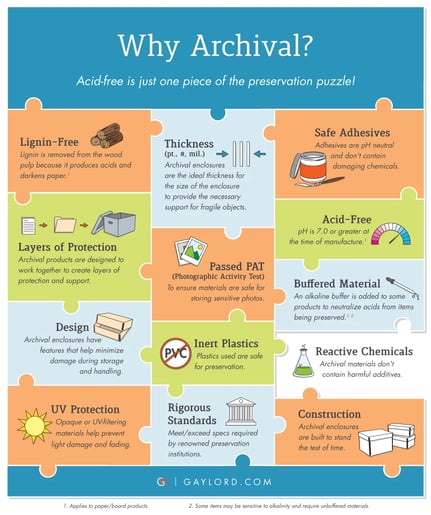Today, we're delving into a basic foundation of preservation: the roles of acid and lignin in the degradation of paper-based materials. While these terms might sound intimidating, understanding them is crucial for anyone interested in preserving historical documents, photographs, and artworks. We'll unravel the mysteries behind acid and lignin, exploring how they accelerate the aging process of paper and why opting for acid- and lignin-free storage materials is essential for the long-term preservation of our cultural heritage.
What are acid and lignin anyway?
Acid and lignin are commonly found in various paper-based materials. Acid accelerates the degradation process by reacting with the cellulose fibers in the paper, causing yellowing, brittleness, and overall deterioration. On the other hand, lignin is a natural component in wood that binds the fibers together. However, as it breaks down it becomes acidic, contributing to the deterioration of paper materials.
How does the deterioration happen?
Acid causes a reaction that corrodes the cellulose fibers within the paper. Over time, the corrosion shows up as yellowing and brittleness, robbing your artifacts of their original vibrancy. As lignin breaks down it becomes acidic. The increased acidity acts as a catalyst that compromises the integrity of the paper, resulting in a domino effect of fading colors, discoloration, and eventual crumbling.
Even if a product is acid-free at the time of manufacture, if it still contains lignin, it risks becoming acidic over time.
how do acid- and lignin-free storage materials help?
Unlike their conventional counterparts, acid- and lignin-free paper materials are manufactured to strict specifications set by the U.S. Library of Congress. You can learn more about those specifications in our post on Material Specifications.
Acid migration occurs when acidic compounds from one material transfer or migrate to another, leading to accelerated deterioration. If you're storing acidic documents in acidic folders in acidic boxes - that's a whole lot of deterioration. By using acid- and lignin-free folders and boxes, you insulate your items from damage caused by acid.

.png?width=600&height=515&name=2401-Guide%20on%20Tablet(1).png)
Gaylord Archival Guide to Collections Care
Written by conservators, our illustrated primer covers the proper handling and storage of paper, photographs, textiles and books. This guide also includes the introduction to book repair featured in our Bookcraft Book Repair Guide.

